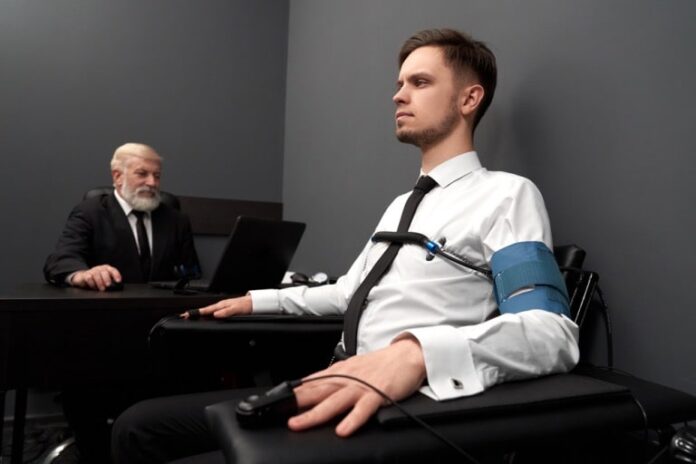Getting to the bottom of an investigation has always been one of humankind’s greatest challenges. Since no one can read minds, you can only take a person’s word for it when no evidence suggests otherwise.
These days, we have a procedure using a polygraph (or lie detector) instrument that can help solve this problem. Although this technology doesn’t point out lies, it uses changes in human physiology to determine the likelihood of inaccuracies in a statement.
The polygraph has come a long way with no signs of slowing down. Already, many industries and organizations are adopting this technology for critical assignments. Ongoing trends suggest this machine will soon be a mainstay in virtually all sectors.
Before exploring its applications and benefits, let’s take a trip down memory lane and uncover the history of the polygraph.
Lie Detection Before the Polygraph
Throughout history, humans have forged various techniques to get the truth out of an interesting figure. Before modern times, torture was the go-to method for getting people to tell the truth.
While it can be effective, history shows humans will say anything to escape their misery, including self-indicting confessions. This led to the search for creative, humane, and more accurate methods for lie detection. Some are still practiced in rural areas.
In Africa, elders or community heads would test a person’s credibility by asking them to confirm something non-existent. For example, they might pause mid-question to ask why the examinee has a grain of rice on their cheek when there’s none. Anything but a rebuttal would be considered a sign of dishonesty.
Similar tests were also conducted in Asia and other parts of the world. While traditional practices were sometimes helpful, they were questionable and unsuitable for many scenarios.
19th Century Inventors
A new approach to lie detection started when people began to pay attention to physiological responses. The earliest known contributors to the modern Polygraph were physiologist Angelo Mosso and criminologist Cesare Lombroso.
In the late 19th century, Mosso used the plethysmograph to demonstrate how breathing patterns affect blood pressure and pulse rates under certain conditions. This occurred after the scientist studied blood pressure spikes with respiratory intensities due to fear or unease.
Nearly two decades later, the Italian criminologist, Lombroso, invented a glove (Lombroso’s Glove) that measures blood pressure to identify inaccurate testimonies. Lombroso’s Glove probably took some inspiration from Galileo’s invention for calculating the human pulse in the 16th century, which was not intended for criminal investigations.
20th Century Inventors
The beginning of the 20th century ushered in some of the most groundbreaking innovations, including Dr James McKenzie’s finest work. The cardiologist invented a venous and arterial pulse measuring device that would become the foundation of modern polygraphs.
Since then, more scientists have contributed immensely to creating the modern polygraph through extensive and detailed research. For instance, John Larson invented the first modern polygraph in 1921, capable of measuring changes in vital signs simultaneously.
Meanwhile, Leonarde Keeler refined the polygraph by making it portable while adding the galvanic skin response (GSR) feature. The GSR is crucial in measuring the changes in body conductivity during questioning.
Accuracy of Polygraph Test Results
The accuracy of polygraphs is steadily increasing, as results range from 85% to 95% correctness. These results encourage reliance on the machine for sensitive tasks. However, the jury is still out on the correctness of polygraph test results.
Many have argued that nervousness could be mistaken for deception, leading to the indictment of innocent people who may have anxiety challenges. This is also one of the reasons for its limited admissibility in court.
Modern procedures or applications in various industries depend on technology, and polygraphs are no exception. Modern polygraphs are computerized, using software to record and analyze data in real-time. Work is underway to further improve the accuracy of the test results by adopting algorithms.
Modern-Day Application of Polygraphs
Thanks to the efforts of past and current scientists, the polygraph’s use has transcended the medical field and law enforcement. Modern polygraph tests have become integral to many sectors and are used in various ways. These are the most common uses of this technology.
1. Government Agencies or Public Offices
Various federal agencies have adopted the polygraph into their daily operations. For agencies like the FBI or CIA, this technology does more than screen candidates before recruitment. Polygraphs are part of the security detail for issuing security clearances and gaining access to the facility.
2. Law Enforcement and Criminal Investigation
The polygraph is mostly used in law enforcement to help uncover mysteries and solve crimes. It can be effective in criminal investigations and in narrowing down lists of suspects. It was crucial to the infamous Jack Ruby case in connection with the assassination of President John F. Kennedy.
3. Private Pre-Employment
Private companies have also adopted the use of the polygraph for pre-employment screening. They mainly use them for recruiting or promoting candidates with authorization to handle sensitive information.
It helps them select candidates they can trust with confidential projects or data. Besides employment, private companies may also use it for internal investigations.
4. Recreation
The popularity of the polygraph means it’s only a matter of time until it becomes gamified. Nowadays, toy polygraphs are entering the market. Gamified polygraphs are mainly for recreational activities.
These types are typically made of plastic or other materials of lower quality with less accuracy compared to those used in law enforcement. They may either give a buzzing sound or produce a mini shock whenever the user or examiner gives a false statement.
Final Thoughts
Before the advent of the polygraph, various cultures and civilizations had come up with ways to detect lies. For the most part, torture became the go-to practice, which is a cruel and flawed approach. This paved the way for the polygraph’s gradual invention.
Since the 19th century, many scientists have contributed tremendously to the modern-day polygraph. As the accuracy of polygraph results surges, private and government agencies have adopted this technology for daily operations.
Overall, as modern scientists apply sophisticated technology to upgrade this machine, it’s only a matter of time before it reaches absolute accuracy.




